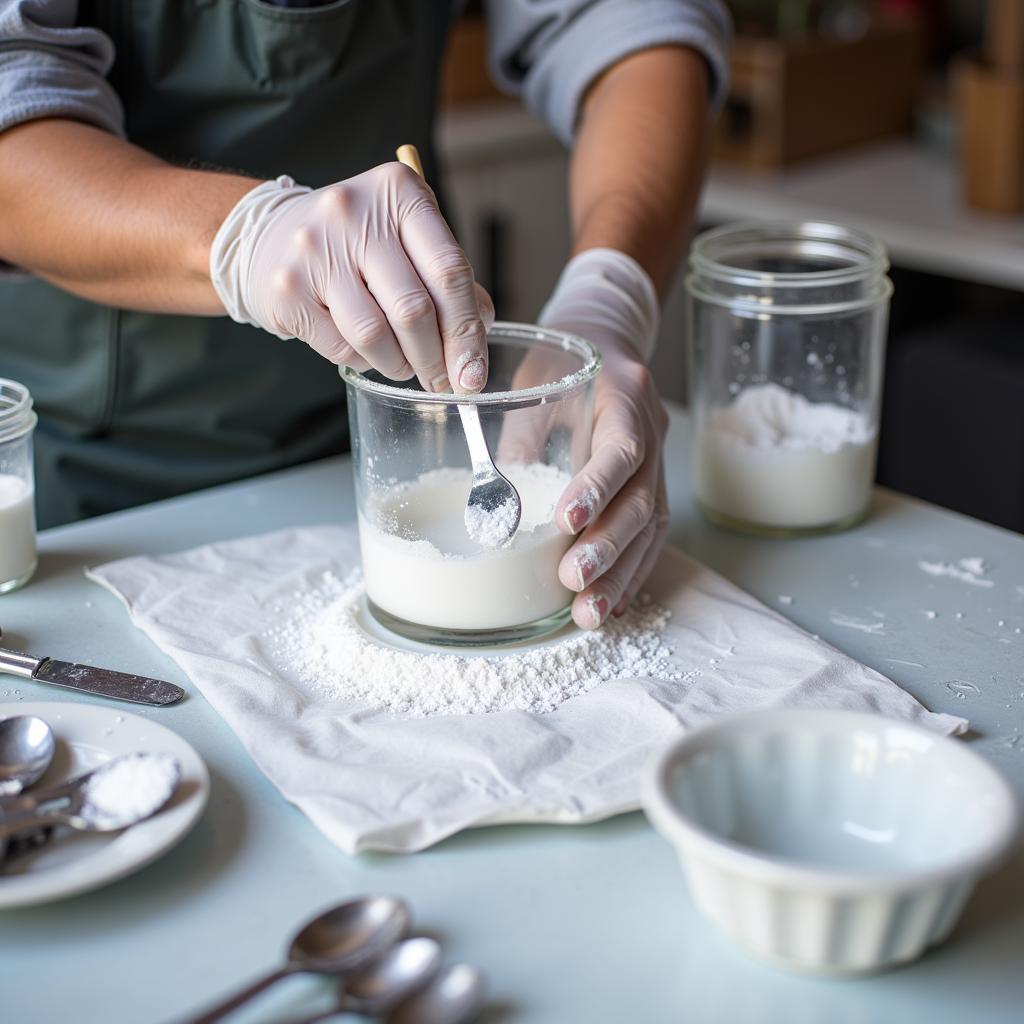Creating the perfect white paint might seem simple, but achieving a specific shade and finish requires a bit of knowledge. Whether you’re looking for a crisp, cool white, a warm, inviting white, or something in between, understanding how to make white paint opens up a world of possibilities for your next project. This guide will take you through the process, explaining the different components involved in creating white paint and offering tips for achieving your desired results. You can even learn how colors interact, for example, what color do orange and blue make?
Understanding White Paint Components
White paint isn’t just one thing; it’s a combination of pigments, binders, and solvents. The pigment provides the color (in this case, white), the binder holds the pigment together and allows it to adhere to surfaces, and the solvent thins the paint for application. Mastering these components is key to how to make the color white paint.
Pigments: The Heart of White
Titanium dioxide is the most common pigment used in white paint due to its bright, opaque qualities. Other pigments like zinc white and lead white were used historically but are less common today due to toxicity concerns.
Binders: Holding It All Together
Binders play a crucial role in the durability and finish of your white paint. Common binders include acrylic, oil, and alkyd resins. Acrylic binders offer quick drying times and low odor, while oil-based binders provide a richer, more durable finish.
Solvents: Thinning and Application
Solvents determine the consistency and drying time of the paint. Water is the solvent for acrylic paints, while mineral spirits or turpentine are used for oil-based paints. Choosing the right solvent is essential for achieving the desired application properties.
 Mixing Pigments and Binders to Create White Paint
Mixing Pigments and Binders to Create White Paint
Mixing Your Own White Paint
While ready-made white paints are readily available, creating your own allows for precise color customization. Here’s a step-by-step guide on how to make the color white paint:
- Choose your pigment: Select a high-quality titanium dioxide pigment for the brightest white.
- Select your binder: Consider the surface you’re painting and desired finish when choosing your binder. Acrylic is versatile, while oil-based provides a more durable finish.
- Measure carefully: Use precise measurements to achieve the desired color and consistency. Start with a small batch to test the ratio of pigment to binder.
- Mix thoroughly: Combine the pigment and binder slowly, ensuring even distribution. Use a palette knife or similar tool to avoid clumps.
- Add solvent gradually: Thin the mixture with the appropriate solvent until the desired consistency is reached. Test the paint on a scrap piece before applying it to your final surface.
Achieving Different Shades of White
While pure white is an option, you can achieve various shades by adding small amounts of other pigments. For a warmer white, add a touch of yellow ochre or raw sienna. If you’re curious about other color combinations, you might wonder, what colors go with gray and red? For a cooler white, incorporate a small amount of blue or violet. Experimentation is key!
Tips for Success
- Always wear protective gear, including gloves and a mask, when working with pigments and solvents.
- Use clean tools and containers to prevent contamination.
- Test your white paint mixture on a small, inconspicuous area before applying it to the entire surface.
- Store your mixed paint in airtight containers to prevent drying.
“Understanding the nuances of white paint is crucial for achieving the desired effect,” says renowned color consultant, Anya Sharma. “Experimenting with different pigments and binders allows you to create a truly unique and personalized finish.”
Conclusion
Learning how to make the color white paint provides creative control and allows for customized results. By understanding the components involved and following the steps outlined above, you can achieve the perfect shade of white for any project.
FAQ
-
What is the best white pigment for making paint?
Titanium dioxide is generally the preferred pigment for its brightness and opacity. -
Can I mix different types of binders?
It’s generally not recommended to mix different binder types as they may not be compatible. -
How long does mixed white paint last?
Properly stored in airtight containers, mixed paint can last several months. -
How can I achieve a warmer white?
Add small amounts of warm pigments like yellow ochre or raw sienna. -
What is the most common binder used in white paint?
Acrylic binders are commonly used due to their versatility and low odor.
Have you ever considered the diverse ways color is created? For instance, how does whiskey get its color? Or, if you’re into baking, you might be interested in learning can you color fondant? For other metallic paint options, you might want to know how to make silver color paint.
Need help with your next painting project? Contact us! Phone: 0373298888, Email: [email protected] or visit us at 86 Cầu Giấy, Hà Nội. Our customer service team is available 24/7.

